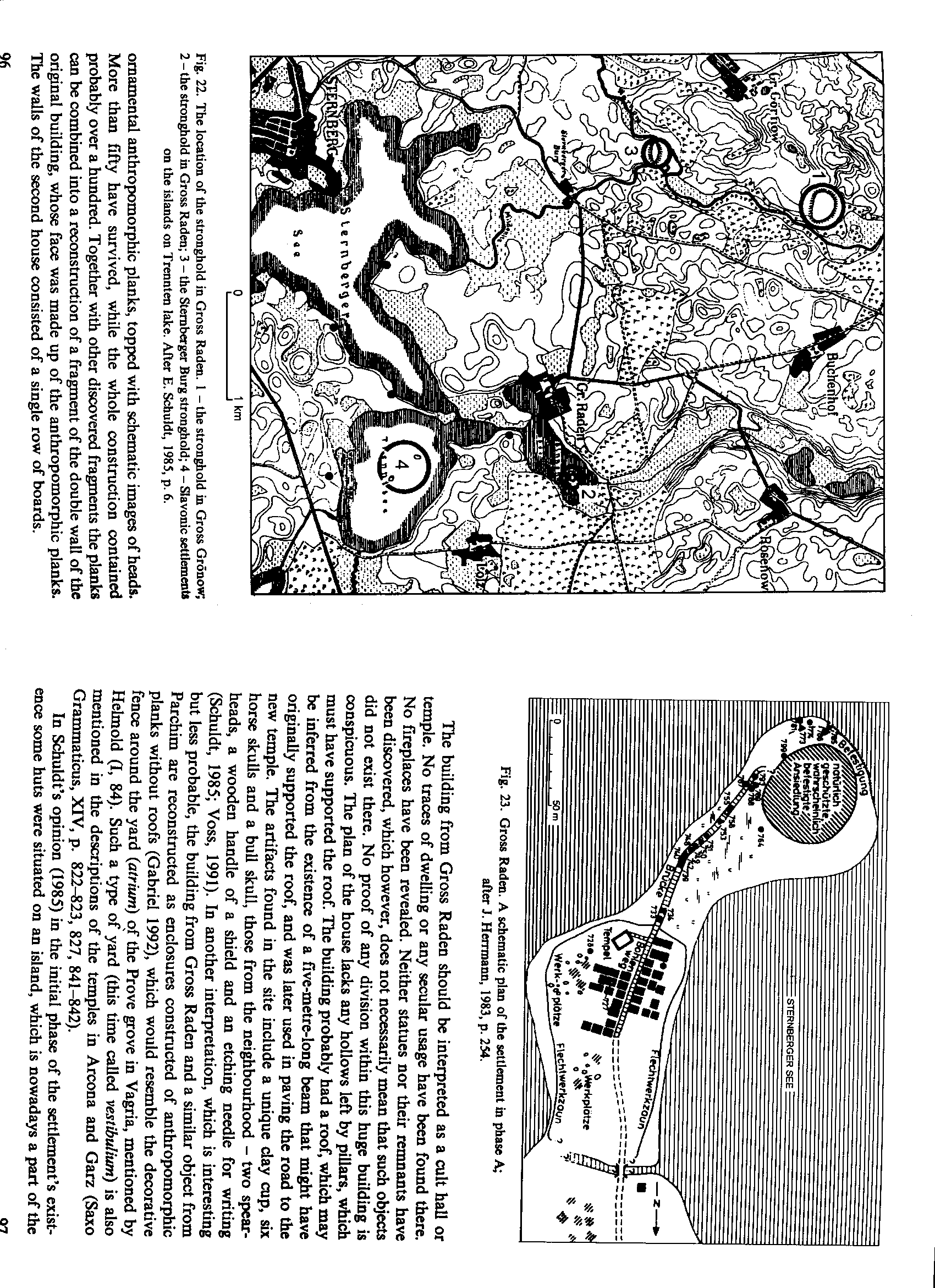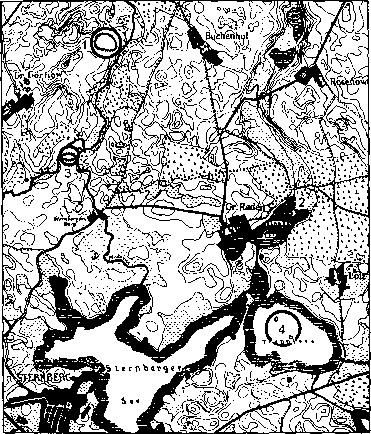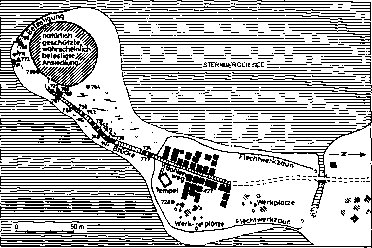image047


Fig. 22. The location of the stronghold in Gross Raden. 1 - the stronghold in Gross Grónow; 2 - the stronghold in Gross Raden; 3 - the Sternberger Burg stronghold; 4 - Slavonic settlements on the islands on Trennten lakę. After E. Schuldt, 1985, p. 6.
omamental anthropomorphic planks, toppcd with schematic images of heads. Morę than fifty have survived, while the whole construction contained probably over a hundred. Together with other discovered fragments the planks can be combined into a reconstruction of a fragment of the double wali of the original building, whose face was madę up of the anthropomorphic planks. The walls of the second house consisted of a single row of boards.

Fig. 23. Gross Raden. A scheraatic plan of the settlement in phase A; after J. Herrroann, 1983, p. 254.
The building from Gross Raden should be interpreted as a cult hall or tempie. No traces of dwelling or any secular usage have been found there. No fireplaces have been revealed. Neither statues nor their remnants have been discovered, which however, does not necessarily mean that such objects did not exist there. No proof of any division within this huge building is conspicuous. The plan of the house lacks any hollows left by pillars, which must have supported the roof. The building probably had a roof, which may be inferred from the existence of a five-metre-long beam that might have originally supported the roof, and was later used in paving the road to the new tempie. The artifacts found in the site include a uniąue day cup, six horse skulls and a buli skuli, those from the neighbourhood - two spear-heads, a wooden handle of a shield and an etching needle for writing (Schuldt, 1985; Voss, 1991). In another interpretation, which is interesting but less probable, the building from Gross Raden and a similar object from Parchim are reconstructed as enclosures constructed of anthropomorphic planks without roofs (Gabriel 1992), which would resemble the decorative fence around the yard (atrium) of the Prove grove in Vagria, mentioned by Helmold (I, 84). Such a type of yard (this time called yestibulium) is also mentioned in the descriptions of the temples in Arcona and Garz (Saxo Grammaticus, XIV, p. 822-823, 827, 841-842).
In Schuldfs opinion (1985) in the initial phase of the settlemenfs exist-ence some huts were situated on an island, which is nowadays a part of the
tri
Wyszukiwarka
Podobne podstrony:
image090 Fig. 73. The alleged sanctuary on Bogit mountain. The stronghold. The cult circle. The alle
image017 Fig. 10. The plan of the stronghold m Arcona reconstructed by H.Berlekamp and J.Herrmann. A
image042 Fig. 18. The topography of the early-raedjevaj Wolin. A - the presumed location of the temp
image078 Fig. 66. The sanctuary in Rzhavintse. Top: a plan of the stronghold with sounding excavatio
image083 Fig. 67. The enthroning ceremony of a Carinthian prince on an engraving from Osłerreichisch
image089 Fig- 71. The stoi»e walls around the peak of Góra Dobrzeszowska. 1 - the internal wali; 2 -
image100 Psrdwln Fig. 79. The location of Triglav’s sanctuary in Brandenburg-Brenna on Triglav’s Hil
22 JACEK LECH tory of the flint minę at Bębło near Cracow (Fig. 22). The excavated depth of No 1 was
image049 1 m Fig. 26. The profile and plan of the remains of Ihe south-ea&tem wali base of the t
image063 Fig. 47. Trzebiatów. A plan of the town and its surroundings. A - the cult place on David H
image064 Fig. 49. The alleged cult circle at Parsteiner lakę near Pehlitz. K - the drcle; R - ruins
image094 Fig. 75. The Krak Mound near Cracow. Photo L. Słupecki. is banished, and as the małe linę i
image002 Figurę I: Distribution and spread of adansonii hybrid in South America. Adapted from Townse
DSC07912 I Fig. 10. Depositional sequence of a dejection cone in National Naturę Reserve near Velka
P1130010 Fig. 13: Corpus hiteum of pregnancy (airows) in a marę on Fig. 130: Two c
image054 Fig. 36. Starigard (Oldenburg). The location of the stronghold; after M. Muller-Wille, 1988
image023 Fig. 15. Korzenica-Garz. I, II, m - the alleged traces of temples in the stronghold; after
więcej podobnych podstron